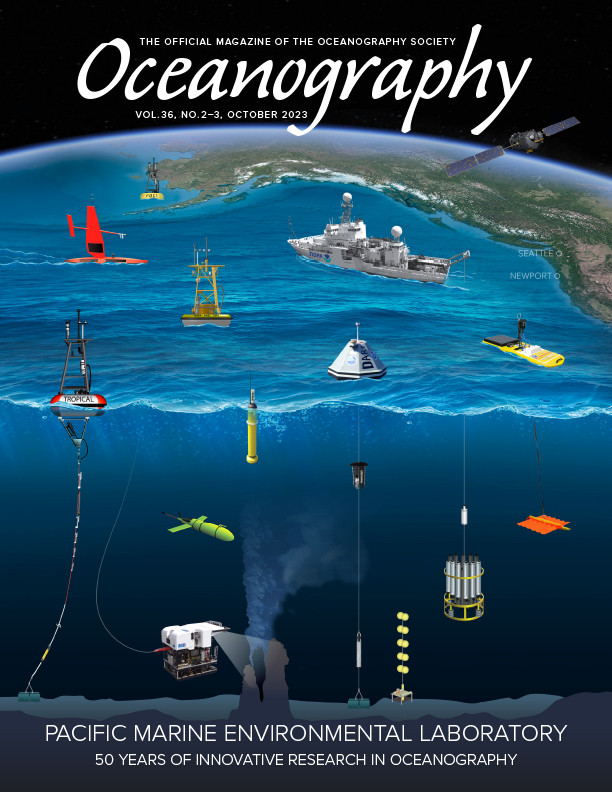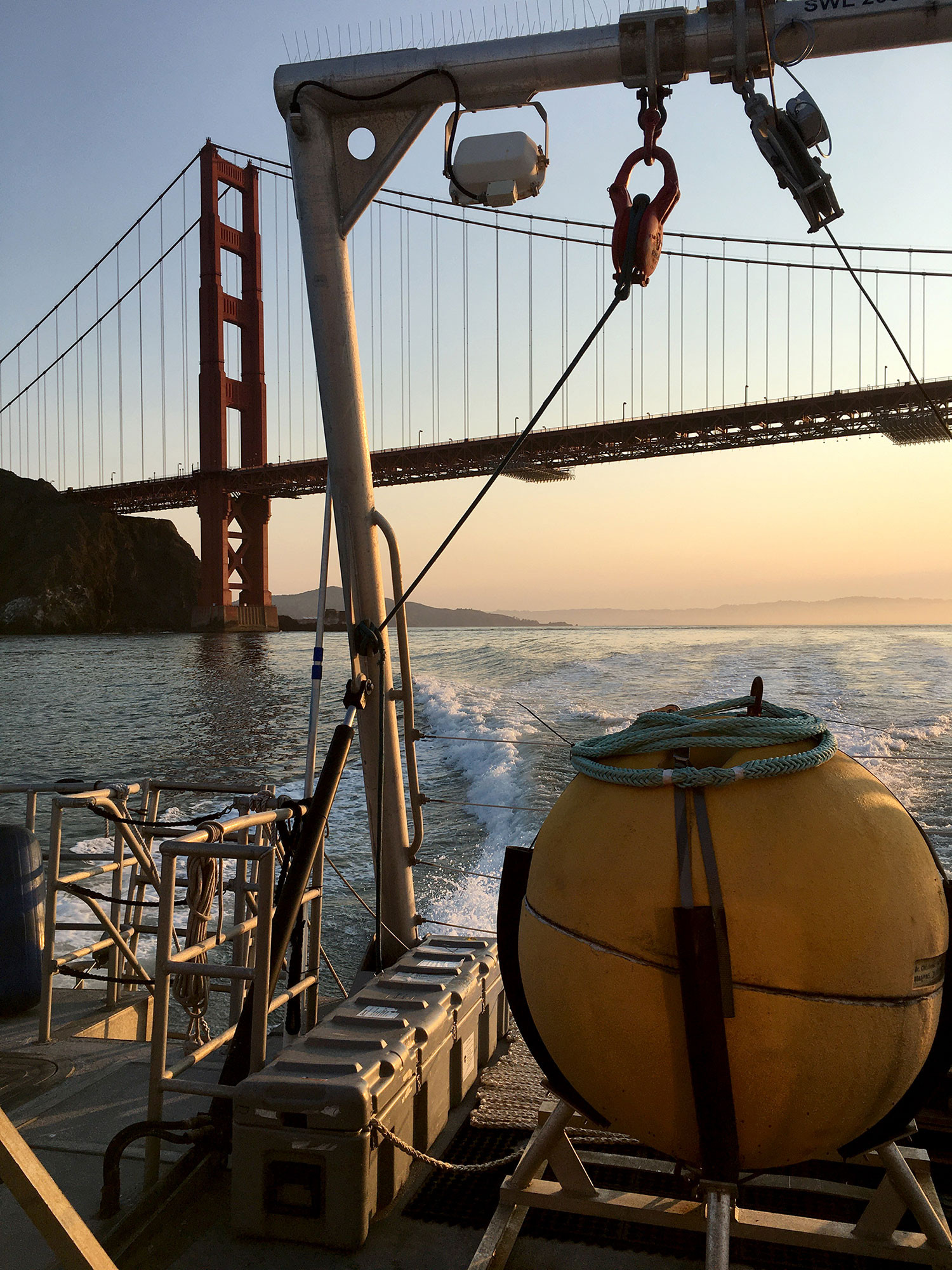Introduction
Passive acoustic methods are ideal for ocean environmental monitoring. Sound waves travel faster in water than in air, and once they enter the Sound Fixing and Ranging (SOFAR) channel, they can travel hundreds to thousands of kilometers with relatively little loss in signal strength (Figure 1). This phenomenon makes sound an effective means of remote sensing throughout the ocean. Individual sources of natural and human-made sound can also be distinguished by their unique signal characteristics in time and frequency, enabling understanding of a wide variety of ocean processes. However, human-made underwater sound can also have a detrimental effect on marine animals by negatively impacting marine ecosystems that are the basis for several sectors of the US maritime economy. Passive acoustic methods are minimally invasive and not restricted by weather or daylight (in contrast to visual surveys), so they can be used to monitor these sensitive marine species and environments without additional disturbance.
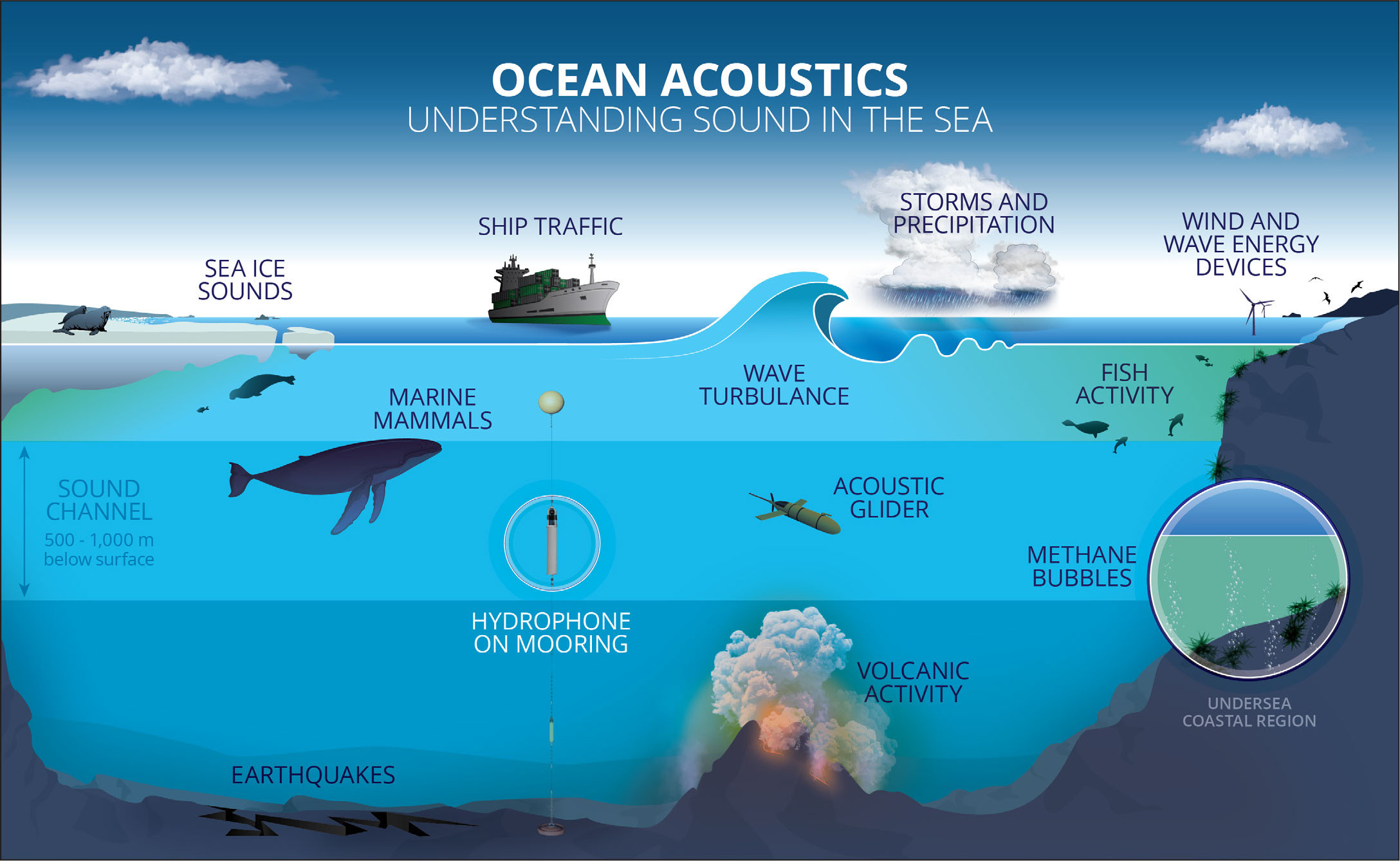
FIGURE 1. Schematic showing the variety of anthropogenic and natural sound sources that may contribute to ambient ocean soundscapes. Passive acoustic methods are ideal for monitoring ocean environments as sound travels faster in water (1,500 m s–1) than in air (340 m s–1). The ocean sound channel, a zone of low sound velocity located ~500–1,000 m deep in temperate oceans, allows sound waves to propagate hundreds of kilometers quickly with little loss in signal strength. Image credit S. Battle. > High res figure
|
In the early 1990s, the NOAA Pacific Marine Environmental Laboratory (PMEL) initiated a groundbreaking project using passive acoustic data from military hydrophone arrays, and in June 1993, the project recorded the first remote observation of a deep-sea volcanic eruption in real time (Dziak et al., 2011a; Hammond et al., 2015).1 The success of this project eventually led to the creation in 2013 of a passive acoustics research group composed of acoustics scientists and ocean engineers focused on quantifying deep-ocean and coastal ambient sound environments. Its overall goal was to develop in-house, novel, passive-acoustic recording technologies that were not available via the private sector. Today, the Acoustics Program continues to develop unique underwater sound recording systems, deploy these systems across the global ocean, and provide insightful acoustic data analysis in fulfillment of NOAA missions.
Our Acoustics Program addresses three main research questions: (1) How do natural and human-made sound sources contribute to total ocean ambient sound levels? (2) What is the impact of human-made sound on marine animals? (3) How can underwater acoustics be used to detect climate change impacts on marine ecosystems? Our program’s vision is to measure the ocean soundscape at local to global scales and to understand what comprises noise—the deviation of ambient sound levels from normal, or natural, acoustic conditions.
1 The online Supplementary Materials provide additional information on the creation and history of the PMEL Acoustics Program. This information also includes additional detail on our passive acoustic technologies and oceanographic platforms, as well as further supplementary background and references on our anthropogenic, geo-, bio- and cryo-acoustics research.
Underwater Acoustic Technology Development
Autonomous Hydrophones: Shallow and Mid-Water
Following the unique and successful real-time use of military cabled hydrophones in the Pacific Ocean, PMEL engineers built a portable hydrophone system that could be deployed anywhere in the global ocean (Figure 2; Fox et al., 2001). This passive-acoustic sensor consists of a single hydrophone, a low-power processor, a filter/amplifier, a clock, and hard drives housed in a titanium pressure case. Referred to as the autonomous underwater hydrophone (AUH; Figure 3a), this system is deployed as part of a subsurface oceanographic mooring comprised of low friction line to reduce strumming and a syntactic foam float to suspend the hydrophone in the sound channel. When the AUH was developed in the mid-1990s, with a 100 Hz sample rate, 50 dB dynamic range, and a relatively low 150 mW power usage, nothing comparable was commercially available (see the online Supplementary Materials).
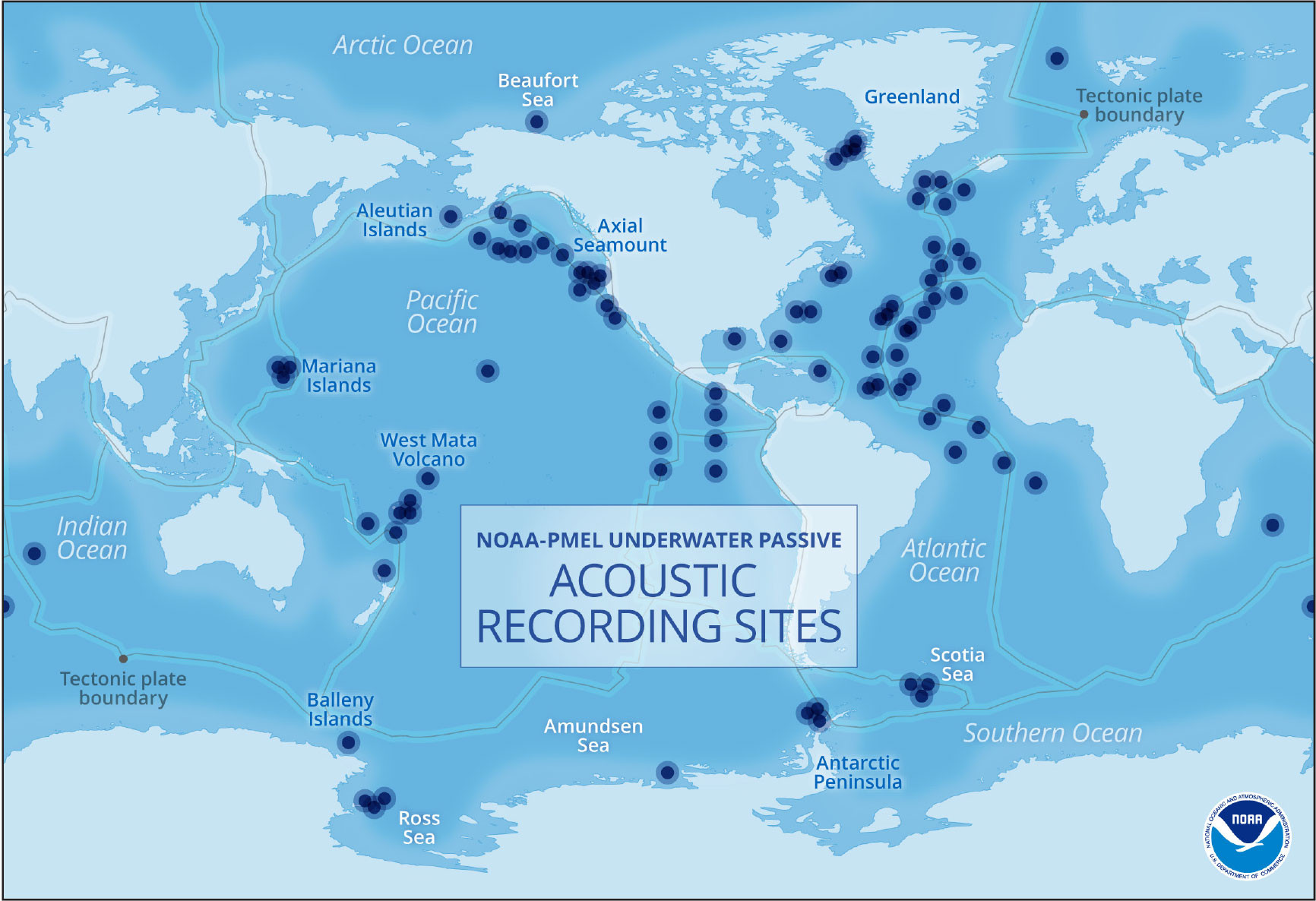
FIGURE 2. Map of PMEL’s underwater passive acoustic recording stations deployed globally since 1995. The deployments span 26 geographic regions across all major ocean basins and in total represent 470 hydrophone-years of acoustic data recordings. Sites include the entire US exclusive economic zone; equatorial and North Atlantic Ocean; north, east, and west tropical Pacific Ocean; and sites within the Indian, Arctic, and Southern Oceans. Additional deployment site names discussed in the text are labeled. Locations of the Ocean Noise Reference Stations are shown in Figure 4. Additional information on deployment dates, geographic locations, and acoustic sample rates are available in Table S1 in the online Supplementary Materials. Image credit: S. Battle > High res figure
|
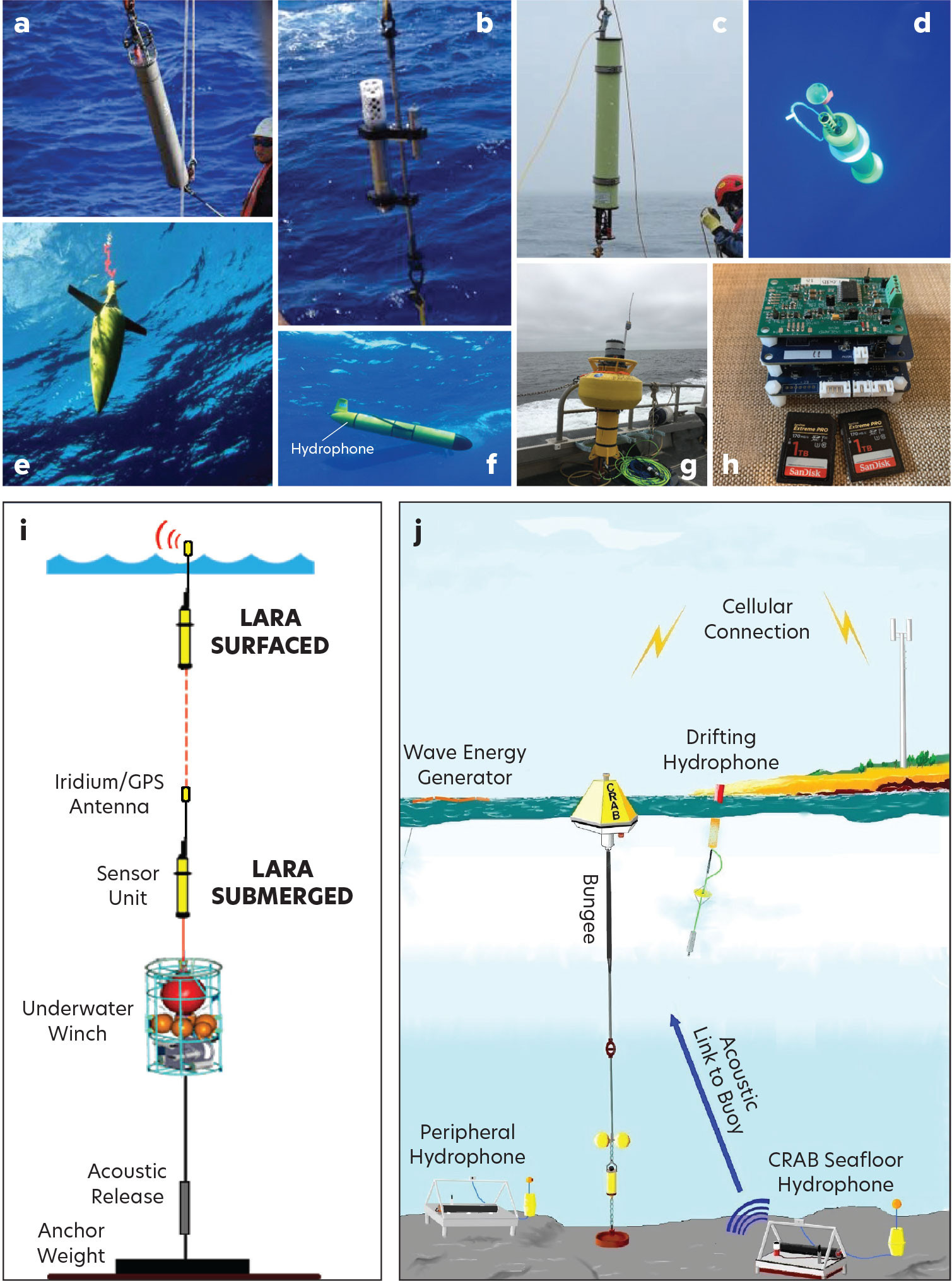
FIGURE 3. Images and schematics of passive acoustic technologies developed by PMEL. (a) The autonomous underwater hydrophone (AUH), with electronics housed in a titanium pressure case. (b) Full-ocean depth hydrophone, recovered at Challenger Deep, with white mesh cage protecting the hydrophone element. (c) AUH in a composite, fiberglass pressure case for shallow-water deployments. (d) The Quasi-Eulerian Hydrophone, or Que-phone, a profiling float fitted with a hydrophone for full water column sound recording. (e,f) Seaglider and Slocum gliders, mobile platforms with embedded passive acoustic modules. (g) A drifting buoy with soft-tethered hydrophone. (h) The Wideband Intelligent Sound Processor and Recorder (WISPR) acoustic data logger, capable of higher sample rates at lower power. (i) The Long-term Acoustic Real-time sensor for Polar areas (LARA), a winch mooring with hydrophone and positively buoyant satellite antenna. (j) The Coastal Real-time Acoustic Buoy (CRAB), a seafloor hydrophone with acoustic modem link to a surface buoy, able to transmit data to cellular networks; peripheral hydrophone mounted in seafloor lander platform also shown. > High res figure
|
Full-Ocean Depth Hydrophone
Successful use of our AUH and mooring system at sound channel depths (~900 m) led to the development of the Full-Ocean Depth Hydrophone (FODH; Figure 3b), a passive acoustic recording system capable of functioning at the maximum depths (~11 km) and extreme pressures (up to 1,100 atm) of the ocean’s hadal zones (Dziak et al., 2017a). The FODH uses an oil-filled, pressure-compensated hydrophone (High Tech Inc.) housed in a pressure case made of 1.8 cm thick titanium that allows the system to withstand extreme hydrostatic pressures. The hydrophone, however, is sensitive to rapid changes in pressure, so it requires a specially ballasted mooring to achieve ascent/descent rates of ~0.5 m s–1.
Mobile Platforms, Surface Buoys, and Near-Real-Time Systems
To increase the spatial coverage of our hydrophone observations, we also embedded our passive acoustic recording systems in a diverse stable of commercially available mobile platforms (Figure 3d–g). These platforms include (1) Slocum and Seaglider underwater gliders that can be piloted from shore along desired routes while recording ocean sound and detecting animal calls in near-real time, (2) drifting surface buoys (Ocean Sonics) and spar buoys with subsurface hydrophones that are soft-tethered to dampen heave noise, and (3) profiling floats that descend to a target depth and remain there for a day or longer, then surface to communicate with shore and acquire a GPS location (Matsumoto et al., 2013). These systems have Iridium satellite antennas that allow near-real-time data transmission to shore stations.
LARA and CRAB Buoys
Over the last decade, we have also been developing moored, passive acoustic systems with satellite and cellular network communication capability that allows for near-real-time data transmission. The first was the Long-term Acoustic Real-Time Sensor for Polar Areas (LARA; Matsumoto et al., 2019; Figure 3i). In the Arctic, use of subsurface and surface moorings is challenging because of seasonal sea ice coverage. To address this issue, the LARA utilizes a commercially available profiler winch (NiGK) with a sensor section consisting of (1) an Iridium satellite antenna with temperature/depth sensors, and (2) a controller, a conductivity-temperature-depth sensor, and a hydrophone within the winch barrel. Once an acoustic event (e.g., a whale call) is detected, a command is sent via modem to the winch to raise the antenna above the sea surface. The control module has an ice sensing algorithm that evaluates ambient sound levels as well as water temperature and salinity, then decides whether or not it is safe to surface the satellite antenna.
Our latest near-real-time technology is the Coastal Real-Time Acoustic Buoy (CRAB; Figure 3j). The CRAB system includes a seafloor hydrophone (50 kHz sample rate) with an acoustic modem link to a surface buoy for shore telemetry via local cell networks (4G). The system can be programmed to be flexible in battery power and data delivery needs, and currently can transmit two ambient sound spectra (2.5 and 25 kHz) six times daily. The CRAB will be deployed at a grid-connected wave-energy device test facility off the Oregon coast. The goal of this project is to report ambient noise levels from various sound sources within the test facility, as well as a suite of other noise exposure metrics.
Microprocessors/Data Loggers
Over the last decade, we have partnered with Embedded Ocean Systems LLC (Figure 3h) to develop the next generation of underwater acoustic data loggers to achieve higher sample rates (5–250 kHz from the original 2 kHz), higher resolution (24 bit from 16 bit), and a 150 dB dynamic range, while still at relatively low power (<210 mW at 50 kHz sampling). Other advancements include on-demand computation of real-time noise spectra and two 1 TB flash memory cards for data storage, and the ability to integrate with small, single-board processors (e.g., Raspberry Pi) for additional storage and automatic detection of desired signals. These latest capabilities represent a dramatic improvement over our first systems developed in the late 1990s.
Automated Marine Mammal Call Detection
Since 2000, we have developed methods and user-friendly software for automatically detecting calls of many species of marine mammals and some fishes (e.g., Mellinger, 2004; Mellinger et al., 2006, 2008, 2011a, 2018). These tools enable us to easily find signals of interest in our recordings, which can be years long—prohibitively long for listening by ear. The methods are based on a variety of techniques, including template matching, following of frequency contours, and machine learning. These call detections have been used for studying species’ seasonal distributions and behavior, and in recent years, in statistical techniques for estimating animal population densities (e.g., Mellinger et al., 2004, 2011b, 2022; Fregosi et al., 2020, 2022).
The Future of Passive Acoustic Technology
Development of the new data logging boards offers insights on the future goals of passive acoustic recording with autonomous systems, with sample rates of hundreds of kilohertz, lower power for longer endurance at sea, and large data-storage capability. Installation of our passive acoustic modules on saildrones and use of distributed acoustic systems (e.g., Bouffaut et al., 2022) offer a vision of more spatially widespread, near-real-time, ocean sound recording.
Passive Acoustics Scientific Research: Anthropogenic Sound
Monitoring ambient ocean sound levels has become the focus of our research efforts. This includes measurements in shallow water (<50 m) as well as deeper glider-based regional surveys (e.g., Haxel et al., 2013, 2019), which revealed that ship noise and wind-induced surface-wave breaking dominate sound levels <100 Hz. We also made the first long-term measurement of ambient sound in Challenger Deep, the deepest spot (~11 km) in the world ocean (Dziak et al., 2017a). Lastly, we showed that the economic downturn during the COVID-19 pandemic resulted in a reduction of ocean sound levels by ~1–2 dB in the North Pacific due to decreased container ship traffic (Dziak et al., 2022). Additional highlights of our ambient sound research are described below and in the online Supplementary Materials.
Ocean Ambient Sound Levels Across US Territorial Waters
In 2016, a milestone in NOAA’s effort to monitor and characterize ocean soundscapes was accomplished with the release of the Ocean Noise Strategy Roadmap (Gedamke et al., 2016). The roadmap highlights the importance of US-wide evaluation of human-made noise levels (10 Hz–2 kHz) within critical marine ecosystems. The implementation plan for the strategy includes the Ocean Noise Reference Station Network (ONRSN; Haver et al., 2018). Deployed in 2015, the ONRSN is a unique partnership between PMEL, NOAA Fisheries, NOAA National Marine Sanctuaries (NMS), the National Park Service, and university collaborators and is composed of 12 PMEL AUH moorings located in or near four national marine sanctuaries, two national parks, and biologically important deep ocean locations in US waters ranging from the Arctic to the tropics (Figure 4a). The ONSRN has enabled long-term, calibrated comparisons of ocean soundscape conditions across US waters, and provided some of the first comparable sound-level metrics, which was not possible prior to this coordinated effort (Haver et al., 2018). Our studies have used ONSRN data to interpret US-wide variability in vessel and other human-made noise (Haver et al., 2018, 2021); illuminate the seasonal distribution of blue, fin, and sperm whales in the Northeast Pacific (Pearson et al., 2023; Kohlman et al., 2023); and compare soundscapes at national parks and sanctuaries (Haver et al., 2019).

FIGURE 4. (a) Map showing the locations of the 12 NOAA/NPS Ocean Noise Reference Station Network sites, ranging from the Arctic to the tropics, including four marine sanctuaries and two national parks. The specific locations are: (1) Alaskan Arctic, Beaufort Sea, (2) Ocean Station PAPA (OSP), (3) Olympic Coast National Marine Sanctuary (OCNMS), (4) Hawai‘i, (5) Channel Islands National Marine Sanctuary (CINMS), (6) Gulf of Mexico (GoM), (7) Southeast United States, (8) Northeast United States, (9) Stellwagen Bank National Marine Sanctuary (SBNMS), (10) National Park of American Samoa, (11) Cordell Bank National Marine Sanctuary (CBNMS), and (12) Buck Island Reef National Monument, US Virgin Islands (VI). (b) Spectral plots comparing monthly median sound levels in September and December 2018 and March and June 2019 at eight sites (Alaskan Arctic, OSP, OCNMS, Hawai‘i, CBNMS, CINMS, GoM, and SBNMS). Site location and time shown were chosen for maximum data overlap. Proximity to large ports (ship traffic) significantly raised sound levels in the Gulf of Mexico, Olympic coast (near Seattle), off central California (Cordell Bank), and OSP sites. Sea ice coverage led to decreased overall sound levels in the Arctic in December, March, and June, with the lowest sound levels in March during peak sea ice extent. Blue/fin whale vocalizations increased levels in September/December 2018, and March 2019 in the ~15 Hz–100 Hz band (~20 Hz and ~45 Hz peaks). In December 2018, blue/fin whale calls increased sound levels at all sites except Alaskan Arctic and Gulf of Mexico. > High res figure
|
Overall, the soundscape conditions at all ONRSN sites (Figure 4b) indicate that at frequencies <100 Hz, median sound levels can vary by up to 30 dB. Sites with the highest sound levels are located in close proximity to commercial shipping lanes and other anthropogenic activities (e.g., ship traffic near the Olympic Coast National Marine Sanctuary and oil and gas exploration and extraction in the Gulf of Mexico). In contrast, lower sound levels were observed at sites where natural features dampened impacts from human-made noise, such as in the Alaskan Arctic where months with sea ice coverage inhibit vessel movement (Haver et al., 2021), and in the Channel Islands National Marine Sanctuary where the hydrophone is shielded by islands from container ship traffic in the Santa Barbara Channel (Pearson et al., 2023). Baleen whales are also a significant driver of sound levels at ONRSN locations, especially along the US West Coast and in the Northwest Atlantic (Haver et al., 2018, 2019, 2020, 2021; Pearson et al., 2023). At these sites, monthly median sound levels increased at frequencies (~15 Hz and ~100 Hz) associated with high energy blue (Balaenoptera musculus) and fin whale (Balaenoptera physalus) vocalizations (Haver et al., 2020; Pearson et al., 2023). The only sites where sound levels did not show seasonal increases related to blue and fin whales were the Alaskan Arctic and the Gulf of Mexico, areas typically outside the range of these species. It is difficult to observe the more subtle influences of other vocal species (e.g., pinnipeds and fishes) that do not vocalize at consistent monthly timeframes. However, previous analyses of ONRSN data revealed the impact of such species at shorter temporal scales (Haver et al., 2019; Munger et al., 2022).
Wave Energy Research
In 2017 PMEL, the Pacific Northwest National Laboratory, and Oregon State University began a multi-year project of acoustic monitoring of a US Department of Energy supported wave-energy converter test facility (PacWave) off the Oregon Coast (Freeman et al., 2022). The goal is to provide PacWave-generated underwater sound information to regulatory agencies in fulfillment of project compliance requirements. To date, we have deployed hydrophone landers and drifting buoys to record baseline sound levels, and plan to deploy a CRAB buoy in summer 2023 to provide transmission of ambient sound spectra every 4 hr to characterize sound levels in near-real time.
Future of Anthropogenic Sound Research
Future objectives for the ONRSN include adding a thirteenth station at a wind-energy site offshore central California, thus expanding our renewable energy monitoring portfolio. We are also planning additional hadal zone sound measurements (e.g., Puerto Rico Trench) to gauge the global extent human-made noise encroaches on these isolated marine ecosystems (Dziak, 2021).
Geophysical Sound
During the 1990s–2000s, PMEL’s access to military hydrophone arrays enabled multiple, seminal studies of deep-ocean (>1,000 m) volcanic activity, and establishment of the link between seafloor volcanism and the release of massive hydrothermal plumes (e.g., Hammond et al., 2015; see also the online Supplementary Materials). However, beginning in the early 2010s, when NOAA’s access to real-time hydrophone data ended, PMEL shifted focus to continued development of autonomous portable hydrophones, thus enabling worldwide deep-ocean geophysical research.
The significant accomplishments of our volcano-seismic work include (1) a global assessment of the use of seismo-acoustic techniques to detect seafloor volcanism over the last century (Tepp and Dziak, 2021), (2) global studies of mid-ocean ridge processes (e.g., Parnell-Turner et al. (2022), (3) a correlation of hydroacoustic tremor magnitude with ash plume height (10–30 k-ft) during the 2017 Bogoslof Volcano eruption in the Aleutian Islands (Tepp et al., 2020), and (4) collecting the acoustic signatures of a 1,225 m deep methane bubble stream on the Oregon continental shelf, among the first such records obtained at a deep-water site (Dziak et al., 2018). Details of our most important volcano research are presented below.
Submarine-Arc and Hotspot Volcano Studies
In 2005 and 2008, detection of explosive volcanic eruptions at NW Rota-1 seamount in the Mariana Islands (Embley et al., 2006) and West Mata volcano in the Southwest Pacific (Resing et al., 2011; the deepest active eruption ever directly observed) led to several in situ video, water column, and acoustic studies (e.g., Chadwick et al., 2008) to better understand the gas-driven processes of these eruptions. In addition, long-term acoustic studies observed the signal character and the annual CO2 gas flux from explosive eruptions at NW Rota-1 (Dziak et al., 2011b), as well as the change of intensity and duration of the eruptions over time at West Mata (Dziak et al., 2015a). We also conducted a Slocum glider-based acoustic survey of West Mata (Matsumoto et al., 2011), showing that sounds from this deep explosive eruption dominated the soundscape at distances up to 30 km (see the online Supplementary Materials).
Submarine eruptions at Axial Seamount (located on the Juan de Fuca Ridge in the Northeast Pacific) were first detected in real time in 1998 (Dziak and Fox, 1999). Axial Seamount erupted again in 2011, but it was detected during in situ investigations using seafloor pressure and acoustic sensors (e.g., Dziak et al., 2012). The acoustic records showed a steady, several-year increase in seismic activity leading up to the April 2011 eruption, as well as a sudden, precursory burst of seismo-acoustic energy 2.6 hr before the eruption began. Real-time seismic monitoring was in place when Axial erupted once again in 2015 (Wilcock et al., 2016), again recording precursory seismic activity. PMEL in situ hydrophones also recorded explosions due to lava-water interaction during this eruption (Caplan-Auerbach et al., 2017).
Future of Geophysical-Acoustic Research
Our future work will be focused on detection of submarine volcanic sources along the central and far western Aleutian Islands. In 2022, we deployed four moored AUHs ~100 km north of Adak Island to enable identification and location of seafloor volcanic sources in an area that is acoustically unmonitored.
Biogenic Sound
Over the last two decades, we have used our moored hydrophones, profiling floats, and gliders to study blue (Balaenoptera musculus), fin (Balaenoptera physalus), and other vocal baleen and odontocete cetacean species in regions across the globe. A few research highlights are provided below, and a full listing of our marine mammal research is available in the online Supplementary Materials.
Endangered Species Call Detection
One of the most important results from our program’s bioacoustics research in the last 10–15 years was the acoustic discovery of a contemporary population of North Atlantic right whales (Eubalaena glacialis) in a traditional nineteenth century whaling ground where they were thought to have been eradicated (Mellinger et al., 2011b). North Atlantic right whales are among the rarest cetaceans in the world (Kraus, et al., 2005), with a population of less than 400, and were thought to occur almost exclusively off the east coast of the United States and Canada. However, a one-year hydrophone array deployment at five sites off Southeast Greenland recorded >2,000 right whale calls, primarily from July to November, indicating a broader presence of right whales in this region than previously thought.
We have also detected a novel cetacean call, since found to be from Bryde’s whales, in the western North Pacific (Nieukirk et al., 2016). This was done using deep-diving gliders equipped with passive acoustic sensors. The new call was detected over the Mariana Trench and also in much shallower habitats at the depth of continental shelves.
Ocean Temperature Change Impact on Cetacean Distribution
Our work to acoustically quantify the distributions of cetacean populations can also be used to assess ecosystem changes due to a warming ocean, which occur when rising ocean temperatures alter the locations of prey species. Two notable studies explored the link between ocean temperature change and vocal cetacean presence. First, Kohlman et al. (2022) presented evidence of a possible early seasonal presence of blue whale calls during the 2019 marine heatwave in the North Pacific. This heatwave exhibited a peak sea surface temperature anomaly of 3.4°C that coincided with a spike in the summer abundance of chlorophyll and krill (Euphausiacea), suggesting increased productivity in the upper ocean. Second, Nieukirk et al. (2020) presented five years of sei whale (Balaenoptera borealis) acoustic detections east of Greenland (~72°N) at much higher latitudes than typically observed. The presence of unusually warm Atlantic water here likely concentrated their prey and made conditions suitable for this species.
Future of Bio-Acoustic Research
Our future bio-acoustic research will focus on using marine mammal call detections to assess changes in species distributions and densities due to changing ocean temperatures. We also plan further development of real-time technologies for detection of marine mammals. One key effort is use of Seagliders near the Hawaiian Islands for detection of false killer whales (Pseudorca crassidens), an endangered species for which very few data exist (Mellinger et al., 2022). Gliders are also being used for monitoring of cetacean populations as part of NOAA’s mandate to study and protect marine mammals (Fregosi et al., 2022b).
We will also continue our collaborative research quantifying ocean noise stressors on cetaceans off the Oregon coast (e.g., Lemos et al., 2022) and exploring transcriptomics and other biometric tools to detect noise-induced stress. We will also use acoustic techniques to locate Northeast Pacific blue whales to evaluate eDNA sampling methods in the open ocean (Sremba et al., 2019).
Cryogenic Sound
In 2005, the PMEL Acoustics Program began research in Antarctica with hydrophone deployments in a volcanically active basin off the West Antarctic Peninsula (Dziak et al., 2010). However, after several years of geophysical studies, it became clear that seasonal sea ice dynamics and vocal marine mammals are also major components of the ambient soundscape. Thus, we began to quantify all sound sources in the Southern Ocean and expand deployments to include the Scotia, Ross, and Amundsen Seas, as well as the Balleny Islands. Highlights of our Antarctic acoustic research follow.
Antarctic Ambient Sound Levels
The Bransfield Strait, Scotia Sea, and Balleny Islands are areas of dynamic sea ice and iceberg activity that produce thousands of cryogenic sound sources. These sources, icequakes, are generated by collisions and thermo-mechanical fracture of sea ice (Dziak et al., 2015b, 2017b). Icequakes can have high source levels (>190 dB) and are a significant, seasonal ocean sound source. Moreover, Matsumoto et al. (2014) showed that the increase in seasonal volume of circum-Antarctic icebergs generates acoustic energy that dominates low-frequency (10–36 Hz) sound levels across the Southern Hemisphere. This effect is observed in the frequency ranges that are of ecological importance to many marine species (Stafford et al., 1999; see the online Supplementary Materials).
Antarctic Ice Shelf Stability in a Warming Southern Ocean
Warming of Antarctic continental shelf deep waters over the last 40 years (Schmidtko et al., 2014) has led to increased Antarctic ice shelf breakup due to enhanced basal melting (Banwell et al., 2013). The Nansen Ice Shelf (NIS), located along the western Ross Sea, is 2,000 km2 in area and 200 m thick, and has a flow rate of 0.15 km yr–1 (Dow et al., 2018). On April 7, 2016, satellite imagery showed the NIS front disintegrated into two medium-sized icebergs (mass loss of ~37 Gt), the first large-scale calving event here in >30 yr (Li et al., 2016).
Three PMEL hydrophones moored near the NIS recorded hundreds of icequakes caused by the shelf fracturing (Dziak et al., 2019). However, the majority of these icequakes occurred in January 2016, several weeks prior to the calving observed by satellite on April 7. Our interpretation is that the leading edge of the NIS broke free during mid-January but remained pinned until an unusually strong low-pressure atmospheric system freed the icebergs. Thus, in addition to ocean warming, storm systems may play an underappreciated role in Antarctic ice shelf breakup.
Future of Polar Acoustics Research
We plan to continue work in the Beaufort Sea (Figure 4), because the Arctic Ocean soundscape is undergoing dramatic changes as the ice cap recedes and human activities increase. And in partnership with the Korea Polar Research Institute, we will continue acoustic monitoring of East Antarctica ice shelves (e.g., Thwaites) where increased shelf fracturing is of concern due to the potential impact on global sea levels.
Summary: What is the Future of PMEL Passive Acoustics Research?
Over the last two decades, PMEL has been focused on engineering development of novel, portable passive acoustic recording systems for mounting on stationary and mobile platforms, all with near-real-time satellite and cellular communications. These technological advancements have led to numerous scientific discoveries in ambient sound, volcano-, bio-, and cryo-acoustic research throughout the world ocean.
We envision a future for PMEL passive acoustic research that features continued investments in three emerging research initiatives: acoustic monitoring of (1) offshore renewable energy sites, (2) ocean climate change impacts on the distribution of vocal marine mammals, and (3) the stability of Antarctic ice shelves for impact on global sea level rise estimates.
Global advances in seafloor fiber-optic cables (e.g., Ocean Observatory Initiative, 2022), distributed acoustic systems (Bouffaut et al., 2022), surface buoys, and uncrewed vehicles offer an exciting future of near-real-time evaluation of ambient sound to address important environmental issues of our time. In addition to focusing our future passive acoustics research on how human-made noise and climate change impacts marine ecosystems, we will also prioritize archiving of ocean soundscape characteristics so future generations can better understand and mitigate these impacts over time.
Acknowledgments
Our acoustics research was supported by the NOAA PMEL, NOAA Ocean Exploration Program, National Marine Fisheries Office of Science and Technology, the National Ocean Service Sanctuary Program, the National Science Foundation, and the Office of Naval Research. Additional support has been provided by the US National Science Foundation, US Geological Survey, US Department of Energy, US National Park Service, Oregon State University, and the Korean Polar Research Institute. We wish to thank the guest editor and three reviewers for their very helpful comments that greatly improved the manuscript. PMEL’s passive acoustic research was made possible through visionary leadership and incredibly generous contribution of resources and insights from numerous colleagues; the complete list is provided in the online Supplementary Materials. All hydrophone data discussed in this paper are available upon request at https://pmel.noaa.gov/acoustics/ or at the NCEI passive acoustics portal https://www.ncei.noaa.gov/products/passive-acoustic-data. This paper is NOAA PMEL contribution 5473.

